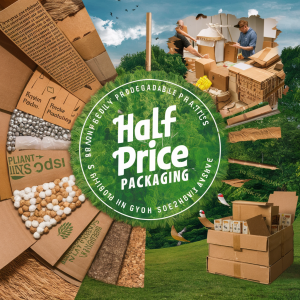
California,USA,1 July,2024-The dilemma is clear: while the packaging may be aesthetically pleasing, its environmental impact is significant.
Every piece of traditional packaging feels like a step backward for our planet, contributing to landfill waste and disrupting marine ecosystems. After all, traditional packaging relies heavily on non-biodegradable materials, leaving a substantial carbon footprint. Millions of tons of plastic packaging end up in landfills and oceans each year, harming wildlife and ecosystems. But there is hope – sustainable packaging.
Half Price Packaging understands this responsibility and is committed to offering sustainable solutions for businesses of all sizes. They are dedicated to eco-friendly practices across the entire packaging lifecycle, from material selection to responsible disposal.
Sustainable Materials: Eco Conscious Material Selection
At Half Price Packaging, sustainability starts with the building blocks – the materials used to create your custom packaging. Here’s how they prioritize eco-conscious choices:
Biodegradable and Compostable Solutions:
In addition to recycled materials, they offer innovative options like packaging made from plant-based materials like mushroom mycelium, bamboo, or hemp. These materials decompose naturally, leaving no harmful traces behind.
- Corn Starch:Used in the production of bioplastics; it’s renewable and compostable.
- Mushroom Mycelium: A natural and compostable material meant for protective packaging.
- Bamboo: It grows rapidly and is a renewable resource for custom boxes.
- Agricultural Waste: Waste materials from farming can be processed into packaging materials.
The use of biodegradable materials like PLA (polylactic acid) derived from corn starch offers a viable alternative to traditional plastics. These materials break down naturally under specific conditions, minimizing landfill waste.
Recycled Content:
A significant portion of their materials are crafted from a high percentage of post-consumer recycled content. This reduces the demand for primary resources.
Right-Sizing for Efficiency:
Using less material is just as important as using sustainable materials. Half Price Packaging’s design team crafts custom packaging that perfectly fits the product requirements, eliminating unnecessary space and reducing overall material usage.
Sustainable Sourcing To Improve Circular Economy:
Wondering how Half Price Packaging ensures their sourcing practices are environmentally responsible?
FSC Certified Materials:
Forests play a vital role in maintaining a healthy planet. So, they prioritized using paper and wood products that are Forest Stewardship Council (FSC) certified. This ensures that the raw materials come from responsibly managed forests, promoting sustainable forestry practices.
Local Whenever Possible:
Transportation contributes significantly to a company’s carbon footprint. That’s why they actively seek to source materials from local suppliers whenever possible. This reduces transportation distances and cuts down emissions associated with delivering materials to their facilities.
End-of-Life Considerations:
End-of-life cycle is an important practice in eco conscious practices, and this is how Half Price Packaging considers it:
Reusability is Key:
They encourage the concept of reusability. Their design experts can create custom packaging that’s sturdy enough to be used for storage or other purposes after the product is consumed. This extends the lifespan of the packaging.
Clear Recycling Labeling:
For packaging that isn’t reusable, clear and concise recycling labels are crucial. Half Price Packaging ensures all their custom designs are clearly marked with the appropriate recycling symbols, making it easier for consumers to dispose of the packaging responsibly.
Compostable Options:
For businesses seeking a truly closed-loop solution, they offer compostable packaging options. These packages readily decompose in commercial composting facilities, returning valuable nutrients back to the soil.
Additional Practices: A Continuous Improvement
Life Cycle Assessment:
Planning the complete life cycle in advance is an effective way to avoid delays and waste in a process. Sustainable packaging considers the environmental impact throughout the product’s life cycle, from material sourcing and production to use and disposal. That’s the reason Half Price Packaging life cycle assessment approach helps identify areas for improvement and optimize the environmental footprint.
Educating for Sustainability:
Empowering customers with knowledge is vital. The company successfully provides clear information about the sustainable features of their packaging and offers guidance on responsible disposal. This empowers consumers to make informed choices and participate in a more sustainable future.
Conclusion
With the prioritization of sustainable materials, minimalist design, and responsible disposal practices, the environmental footprint of the packaging industry can be significantly reduced. As consumers, businesses, and policymakers work together, we can build a future where our online purchases arrive safely without leaving a trail of environmental destruction.
By supporting sustainable practices and making informed choices, we can all play a role in shaping a greener future. One choice is to consider a sustainable packaging solution from Half Price Packaging. They deeply ingrained their approach in Planet, People, and Packaging, so you don’t have to worry about your carbon footprint at all.
Media info:
Website: https://www.halfpricepackaging.com/
Email: sales@halfpricepackaging.com
Contact: +1 866-225-2112
Address: 44288 Fremont Blvd, Fremont, CA, United States, California

